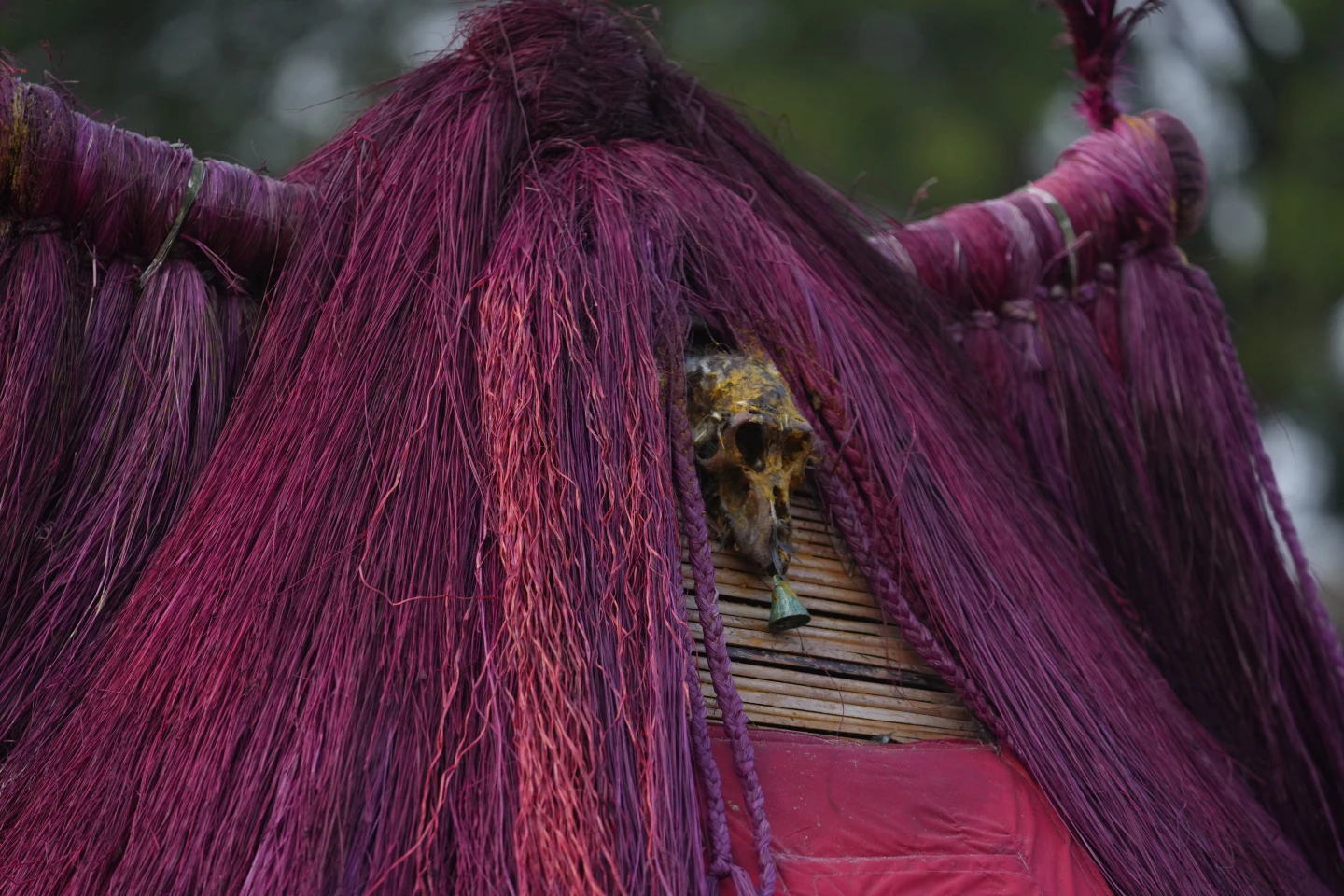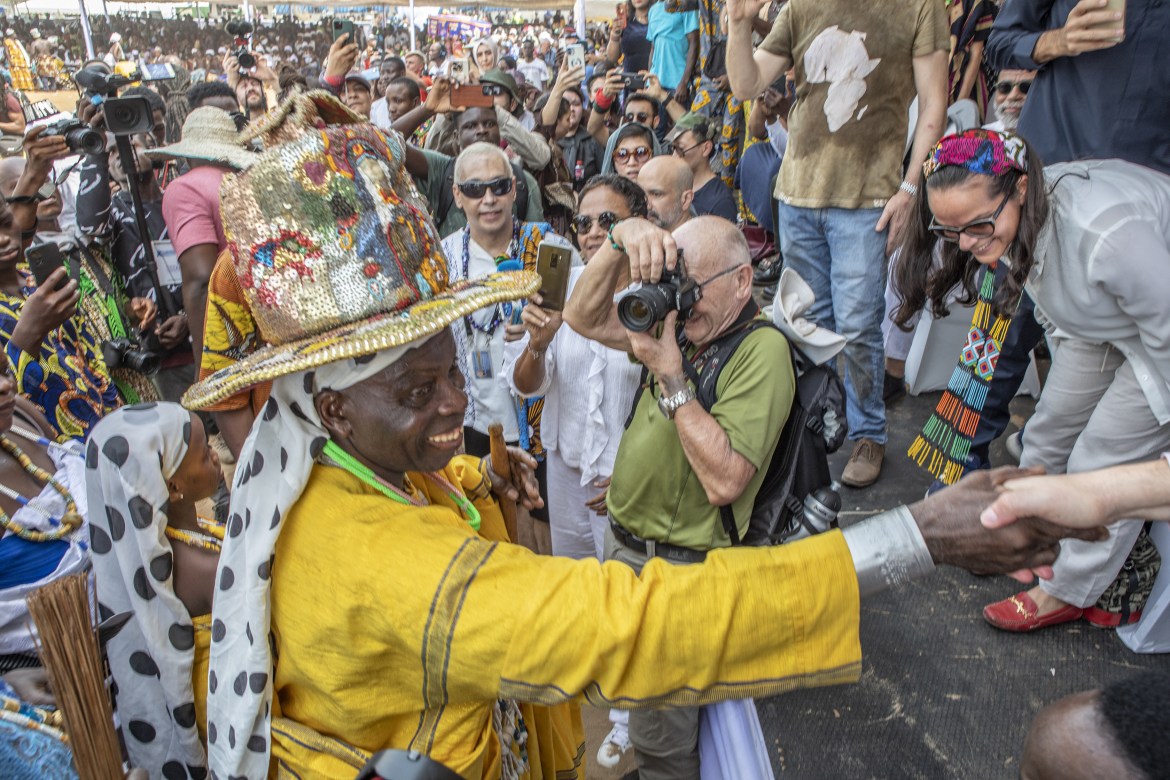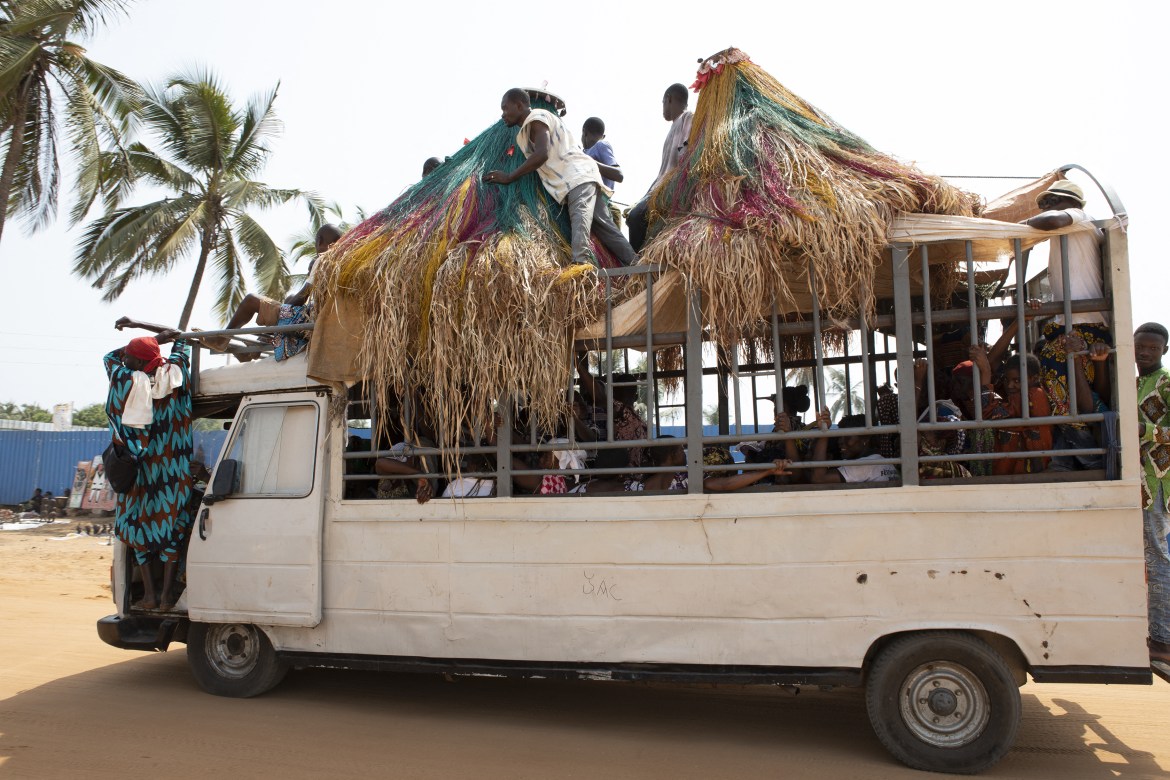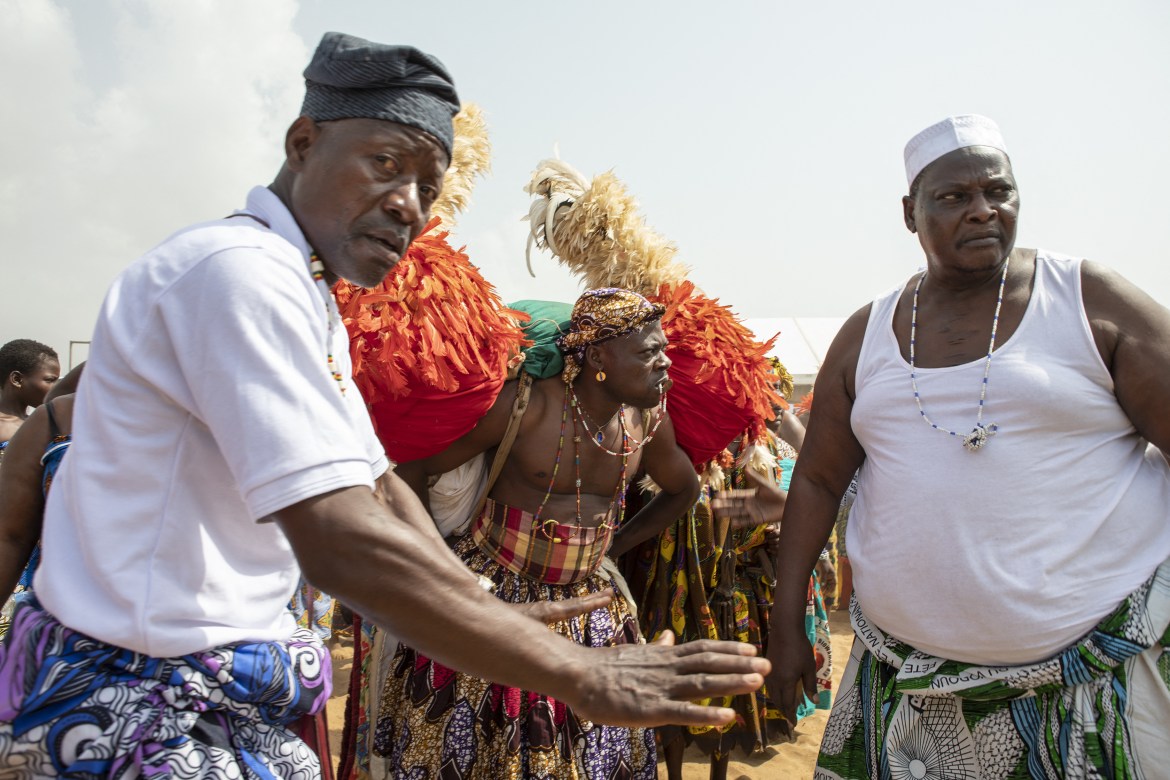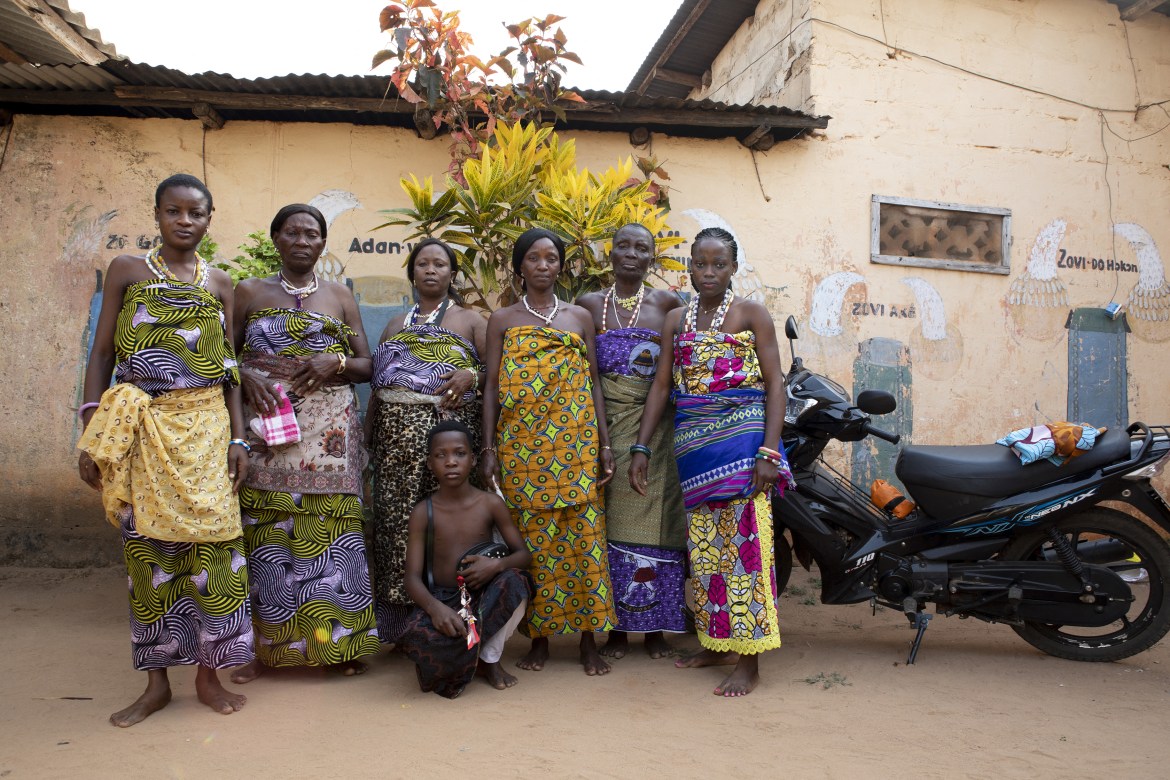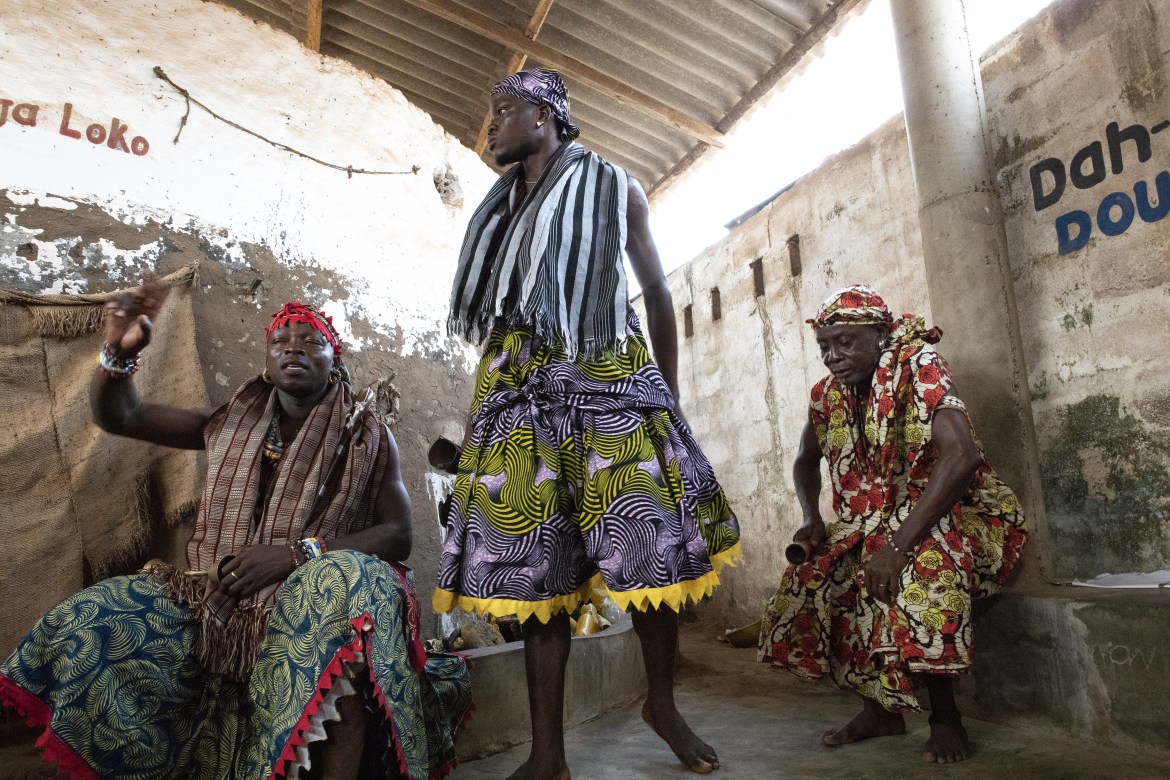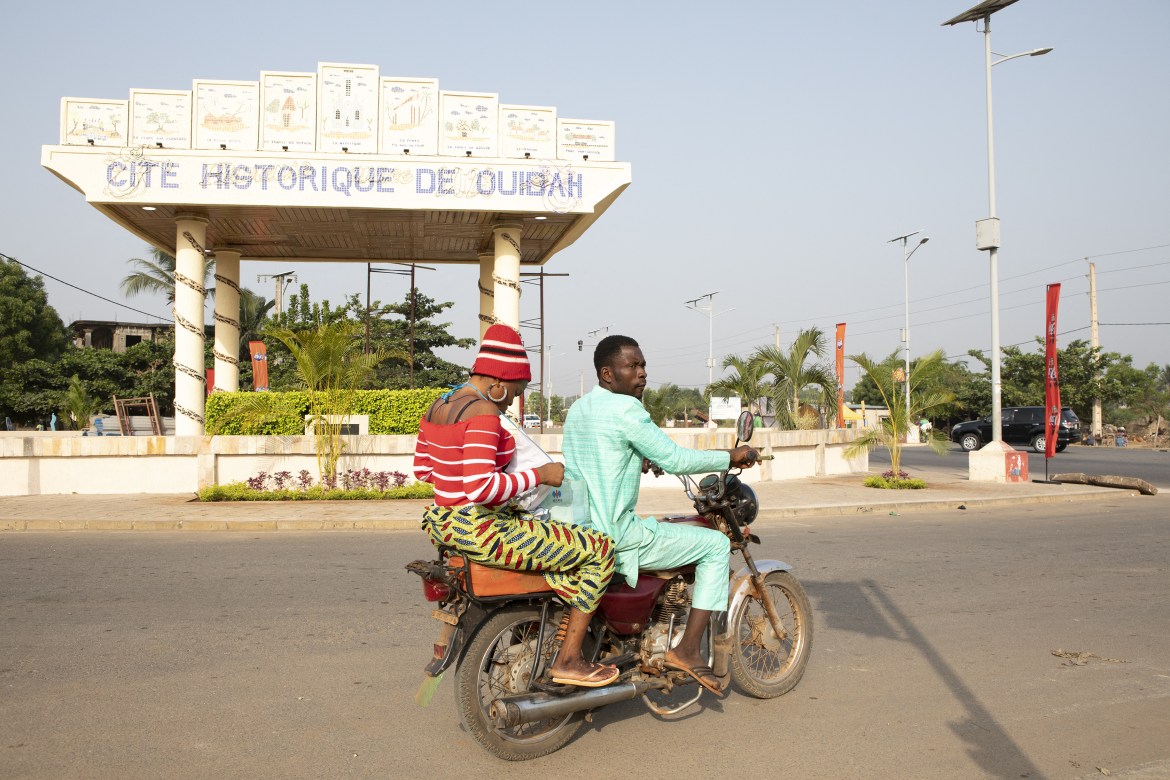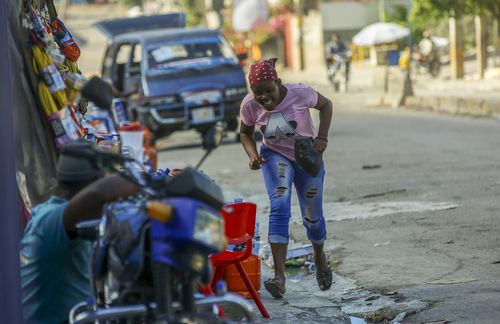Capitalism Never Says “until Death Do Us Part”
ZOMBIES REALLY EXIST.
To find them you must travel to the western third of the island of Hispaniola. Here, you will find the country of Haiti. The first free black (Afro-Caribbean) republic in the world. A country that won its independence from France, then the most powerful country in Europe, by defeating Napoleon's Army in 1804. So while other West Indian nations were evolving under the careful eye of European land owners, Haiti pursued its own path. And having achieved independence at such an early date, Haiti has invented a culture that is unique in the world. A culture built through the syncretism of various African beliefs in conjunction with Native West Indian Taino and European influences. An all encompassing element of the culture is religion. Usually spelled "Voodoo" (though the actual pronunciation is closer to vodoun) these are actually the ceremonies in which practitioners are possessed by the loa, the spirits. As in all religions there exists a tension between good and evil. Most vodoun has little to do with sorcery and black magic. Zombies, however, are one of the exceptions.
ZOMBIES A GO-GO
by John Maxwell, September 26, 2004,
Haiti's history of haplessness began more than 200 years ago when a Jamaican runaway slave called Bouckman lit the spark that fired the Haitian revolution. Bouckman, despite being a giant of a man, a born leader and probably a Muslim (think terrorist) did not survive to see the fruits of the revolution. He was betrayed, captured and his head stuck on a pike to discourage the others -perhaps a primitive attempt at exorcising demonic ideas of freedom and liberty from the revolutionaries.
It didn't work. The Haitians went on to defeat the French colonial forces, then defeated a British expeditionary force and then defeated a French expeditionary army under Napoleon's brother-in-law, killing some 60,000 Frenchmen in the process.
Before that the Haitians had fought alongside the American revolutionaries to help them throw the British out of the American colonies. Haitian help was crucial in at least two battles in which British power was broken - at Savannah, Georgia and at Yorktown.
In addition to all that, the Haitian revolution made another massive contribution to the new American nation: in defeating France, the Haitians exhausted the French treasury to the point where Napoleon had to sell Louisiana to the US or risk losing it to the British. The Louisiana Purchase doubled the size of the US.
So, if the Haitians contributed so much to American independence and development, why is it that in their extremity of grief and suffering, the United States treats the Haitians so meanly? Originally, when the scale of the current disaster became known, the United States, the richest country in the world, offered about US $60,000 for Haitian relief. Venezuela offered $1 million, Trinidad and Tobago earmarked US $5 million while the European Union pledged US$ 1.8 million. Somewhat abashed, the US raised its pledge to US $2 million. In the US itself, where the damage has been far less severe, the federal government alone is contributing more than $6 billion in hurricane relief.
Charity, of course, begins at home or perhaps, it is simply another case of Haitian haplessness. But it must be said, however discreetly, that the United States has had a great deal to do with the current Haitian propensity to catastrophe, by destroying Haitian governments, Haitian infrastructure economic and social, and by policies which have reduced Haiti almost to a desert.
The United States and Britain refused to recognize Haiti after it declared independence The US made recognition conditional on the former colonial power, France, recognizing Haiti's autonomy. At that time, of course, the United States was busy titrating the humanity of blacks and came to the conclusion that a black was 60% human and therefore not entitled to all the rights of Man. And Liberty was as dangerous then as socialism was in the twentieth century.
Three-fifths Human
Oddly, the French, the Americans and the Haitians had all been inspired by the Enlightenment and Tom Paine's codification of the Rights of man. But only the Haitian revolution recognized all those rights. In the US blacks and women, for instance, had to wait more than a century to reach the status guaranteed to Haitians. France and the US maintained slavery more than 50 years after Haiti abolished it.
With the British and the US playing hard-ball on the recognition question, France felt able to demand that the Haitians should pay cash for their freedom. In Jamaica and other British colonies, the state paid the slave-owners compensation. In Haiti the former slaves paid twice, in blood and in treasure. When they had trouble paying back the French the kindly American bankers came to Haiti's rescue. We will lend you the money to pay off your debt, they said, and Haiti achieved another first becoming the first Third world debtor nation.
That debt was eventually paid off more than a century later- the last payment was in 1947. In the meantime it had caused Haiti the most extreme distress, wrecked her infrastructure and destroyed her independence. What the metropolitan countries could not achieve by conquest, they achieved by compound interest.
Early in the last century, the Americans became a little dissatisfied with Haitian repayment of their debt, and that led to an immediate increase in Haitian haplessness. The US invaded, changed their constitution, took away their land, chopped down their trees to plant sisal, logwood, coffee and pineapple and destroyed the agricultural base of the country. After they left officially in 1935, however, the Americans bequeathed Haiti an armed force which was corrupt, cruel, ungovernable and in thrall to the US. It guaranteed that any Haitian President either obeyed Washington or went into exile. In 1947 Dumarsais Estimé, said to be a socialist, was deposed after a couple of years. That began a period of dictatorship distinguished chiefly by American support for the ruthless Duvalier and his inane son, Baby Doc.
During the US occupation (1915 to 1935) the Haitians tried to throw the occupiers out, only to be bombed and strafed in a eerie foretaste of the fascist bombing of Guernica during the Spanish civil war. Nobody made much of the Haitian version, because, after all, what were they but a bunch of "Niggers speaking French" as they were described by William Jennings Bryan, one of Colin Powell's predecessors as US Secretary of State. The Haitian resistance leader, Charlemagne Peralte, was like Bouckman, betrayed, murdered and his head exhibited to discourage the others.
History repeats itself in Haiti, but never as farce.
VOODOO QUEEN
New Orleans had been owned by the French from 1718 to 1762, then by the Spanish until 1803 when it became French again. It was then brought under the American flag through the Louisiana Purchase.
Voodoo had been present in the city before Laveau came upon the scene, but attempts had been made by the authorities to suppress it. In 1782, for example, the Spanish governor Bernardo Galvez forbade the importation of slaves from Martinique because of its people's belief in Voodoo. Additionally, Baron de Carondelet, Spanish governor in New Orleans from 1792 to 1797, fearing the continued spread of Voodoo and also the possibility of slave revolt, disallowed the import of slaves from Santo Domingo. Eventually, a slave revolt would expel European control in Haiti. However, when the Americans came to control New Orleans in 1803, the restriction on slave importation was canceled. Additionally, an influx of free immigrants from Saint Domingue brought 5,000 people, free and slave, to New Orleans from the start of American rule until 1810. Soon, Voodoo began to flourish in American New Orleans.
The French and the Spanish placed severe restrictions on Voodoo practice as well as the limited freedoms allowed for slaves in Colonial New Orleans. The slaves, most of whom had just been directly transported from the West Coast of Africa or the Caribbean, suffered extremely harsh treatment. When not working under the lash, they were confined in buildings or in chains. Following the Louisiana Purchase in 1803, conditions for slaves improved to some extent. Slaves were given Sunday as a day off from labor, and they also had other limited free time at night and on some religious holidays.
On Sundays the slaves were allowed to assemble at an open field near Orleans Street and Rampart Street behind the Quarter, an area which over time had many names -- Circus Public Square, Place des Negres, and even Beauregard Square after the Civil War, in honor of P.G.T. Beauregard, a Confederate general from New Orleans. But the locale's most famous title was Congo Plains (meaning the entire grounds), or Congo Square (meaning a smaller, more frequented portion of the field).
At Congo Square the slaves performed many traditional African dances, including the Bamboula, to the beat of primitive drums. They may have even performed some Voodoo rituals as well, including the worship of Damballa, the Snake god. Although some sources claim no Voodoo worship per se was held in Congo Square, it is clear that this area was a place reserved for the free expression of African culture and customs, especially dancing to the music of the drums. And although the historical record is cloudy, it is possible that some aspects of Voodoo ceremonies were performed there.
Saint Domingue (Haiti), the western part of the once-Spanish island called Hispanola where Columbus had landed, was a colony of France. It produced coffee and sugar under the sweat and blood of imported African slaves. These slaves were brutally treated, and they kept themselves alive only with the aid of their religion. The Yoruba tribe in western Africa was largely responsible for carrying the belief in Vodu to the new world. (Voodoo was also known as Vodu or Vodun.)
In Saint Domingue, the Voodoo priests (or "houngans") and the paid-priests (or "bokors") had used Voodoo charms and potions as a form of biological warfare against the French who enslaved them, even poisoning their food supply on occassion. The Voodoo priests also drugged slaves who had betrayed the cause of slave revolution with Voodoo concoctions from natural herbs and from animal parts and held them as slaves. This is possibly the origin of the zombie.
The zombie was a resurrected body without a soul -- a social outcast who served the will of the Voodoo master. Supposedly, the zombie was raised from the dead, without free will or a soul. However, one modern theory is that the zombie never really died but was the victim of a drug. This Voodoo concoction is believed to have consisted of carefully selected herbs and animal parts, especially from the puffer fish, which contains a neurotoxin that causes a type of paralysis in the nervous system. The Voodoo priest also knew how to apply an antidote which could "resurrect" the zombie, but keep him dazed enough to be easily controlled. Most people, however, did not have the "magical" knowledge of the Voodoo priest. They believed the zombie was actually the living dead, a soulless body returned from the grave. Historically, Voodoo priests used to induce zombiism as a punishment for criminals; additionally, bokors could make someone into a zombie for a fee.
This belief of zombies weaved its way to New Orleans from Haiti as well, although zombies were not known in the Yoruba tribe in Africa. The belief in actual zombies was not as strong in New Orleans as in Haiti, but the term Zombi as certainly used in rituals, as evidenced by Marie Laveau's snake whose name (spoken in a Caribbean French patois) was Li Grand Zombi.
HAITI HISTORY
The Middle Class
The middle class was essentially nonexistent during the nineteenth century. But at about the time of the United States occupation (1915-34), it became more defined. The creation of a professional military and the expansion of government services fostered the development of Haiti's middle class. Educational reform in the 1920s, an upsurge in black consciousness, and the wave of economic prosperity after World War II also contributed to the strengthening of the class. In the late 1980s, the middle class probably made up less than 5 percent of the total population, but it was growing, and it was becoming more politically powerful.
The mulatto elite dominated governments in the 1930s and the early 1940s and thwarted the political aspirations of the black middle class. President Dumarsais Estimé (1946-50) came to power with the aim of strengthening the middle class. The Duvalier government also claimed the allegiance of the black middle class, at least through the 1970s. During the Duvalier period, many in the middle class owed their economic security to the government. A number of individuals from this class, however, benefited from institutionalized corruption.
Some members of the middle class had acquired political power by the 1980s, but most continued to be culturally ambivalent and insecure. Class solidarity, identity, and traditions were all weak. The criteria for membership in the middle class included a nonmanual occupation, a moderate income, literacy, and a mastery of French. Middle-class Haitians sought upward mobility for themselves and their children, and they perceived education and urban residence as two essential keys to achieving higher status. Although they attempted to emulate the lifestyle of the upper class, middle-class Haitians resented the social preeminence and the color prejudice of the elite. Conflicts between the Franco Haitian and the Afro-Haitian cultural traditions were most common among the middle class.
The Tonton Makout Network
The Duvalier dynasty held power longer than any other regime in Haitian history. The duration of the dynasty enabled the thorough entrenchment of Duvalierist institutions and the development of a patronage system. One of the more important of these institutions was the VSN. After the VSN's dissolution, former tonton makout leaders remained at large, and some were politically active throughout the post-Duvalier period. The old makout networks also continued to function within the army. As of 1989, they were the main obstacle to free, fair, and popular elections in Haiti, and thet were the most significant threat to domestic security.
Through the VSN, the Duvalier regime had politicized rural Haiti. The VSN had expanded the president's influence to remote areas, and it had incorporated rural Haiti into a political system once limited almost exclusively to Port-au-Prince. The VSN had assured political control of the hinterlands, but it had given peasants no new voice in the political process. It had created a rural awareness of Port-au-Prince and events there, however, a consciousness of the national political system, and new political aspirations. The VSN had engendered a generalized disrespect for political institutions, and it had heightened expectations of profit from the political system.
Labour
Haiti's 1989 labor force was estimated at 2.8 million people. The economically active population (those over age ten), however, represented more than half of the country's total 6.1 million population. Forty-two percent of the official work force was female, ranking the country's female participation as one of the highest among developing countries. In rural areas, however, the role of women in production and commerce was apparently much greater than these statistics indicated.
The distribution of the labor force by economic sector from 1950 to 1987 reflected a shift from agriculture to services, with some growth in industry. Despite these changes, agriculture continued to dominate economic activity in the 1980s, employing 66 percent of the labor force; it was followed by services, 24 percent, and industry, 10 percent. Based on these figures, Haiti continued to be the most agrarian, and the least industrial, society in the Western Hemisphere. The country's employment of only 50,000 salaried workers in 1988 was further evidence of the traditional character of the work force.
Statistics on employment and the methodologies used to gather such data varied widely; most unemployment figures were only estimates. In 1987 the United States Department of Labor estimated that Haiti's unemployment rate was 49 percent. Other estimates ranged from 30 to 70 percent. Official unemployment was severe in Port-au-Prince, but comparatively low in rural areas, reflecting urban migration trends, rapid population growth, and the low number of skilled and semi-skilled workers.
Haiti established a labor code in 1961, but revised it in March 1984 to bring legislation more in line with standards set by the International Labour Office (ILO). Conformity with ILO guidelines was a prerequisite for certification under the Caribbean Basin Initiative (CBI--see Appendix B) enacted by the United States Congress in 1983.
Haiti's most fundamental labor law, the minimum wage, was also the most controversial. Low wage rates attracted foreign assembly operations. In 1989 the average minimum wage stood at the equivalent of US$3 a day, with some small variations for different types of assembly work. The minimum wage in the late 1980s was below the 1970 level in real terms, but assembly manufacturers and government officials refused to increase wages because they needed to remain competitive with other Caribbean countries. Labor laws included an array of provisions protecting workers in the areas of overtime, holidays, night-shift work, and sick leave. The government, however, did not universally enforce many of these provisions. The greatest number of workers' complaints came from assembly plants where seasonal layoffs were common.
The Upper and the Middle Classes
The system of public and private monopolies, including parastatals and import-substitution industries, developed under the Duvaliers. These industries generated great wealth for a handful of powerful families in Port-au-Prince, which resulted in politicized economic decision making. This elite sector saw itself threatened by the fall of the Duvalier regime. Under interim rule, volatile competition arose among certain business interests and military factions. Key members of the business community backed Duvalierist presidential candidates who were likely to protect the lucrative business privileges established under the old regime.
Intermediary classes (those between the wealthy elite and the impoverished masses) grew significantly during the Duvalier era. François Duvalier's political strategy of appealing to the black middle class created a new constituency for political patronage, government employment, and the rapid accumulation of wealth through the political system. The growth of the black middle class was closely linked to the Duvalier era, and it contributed to the tremendous growth of Port-au-Prince after the 1950s.
The long-standing tendencies toward the centralization of wealth and of power in Port-au-Prince greatly increased during the Duvalier era. The income gap between upper and lower income groups widened, and rural areas suffered accordingly. Growing rural-to-urban migration, primarily to Port-au-Prince, and emigration, especially to the United States, also had an impact on the political environment and on aspirations for change. The Duvalier era saw an unprecedented level of emigration to North America along with smaller waves of emigration to other Caribbean countries, Latin America, Europe, and Africa. Emigration had an important impact on Haitian politics. Emigrés maintained numerous fragmented political parties in exile. Emigration also caused huge sums of foreign currency to enter into the economy through remittances. It raised Haitians' consciousness of the outside world, and it led to easier upward social mobility for members of the new intermediary classes by alleviating competition for scarce jobs
VODOU AND HAITIAN POLITICS
Vodou and Haitian politics have influenced each other throughout the history of Haiti. The Haitian Revolution against France was empowered by Vodou - and it was the only successful slave revolt in west of the Atlantic, resulting in the first independent black republic in the Western Hemisphere!
Some Haitian administrations have persecuted Vodou, and in 1915-1934 the occupation of HaitiU.S. military made the eradication of Vodou a priority. Other Haitian administrations have tolerated Vodou, and still others, such as the murderous Duvalier dictatorships, subsidized and subverted the Vodou priesthood.
The United States political scene has sometimes been influenced by Vodou. Following the Haitian revolution the American government refused to recognized Haiti and organized a trade embargo, so great was the fear of rebellion and African religion among the U.S. African slave population. Later American administrations sought to suppress Vodou, and even recently affiliation with Vodou has been used to stigmatize Haitians when determining immigration, foreign aid, and public health policies.
Jesse Helms blocks reproductive health care for Haitian Vodouisants! Published Monday, March 15, 1999, in the Miami Herald: U.S. subsidizing witchcraft, Helms complains. Journalists quickly satirized the rabid Senator Helm's intolerance, and on March 23, 1999, Mat Honan wrote a piece carried on the MoJo Wire, titled Jesse Helms' Political Voodoo.
Three Protestant pastors were arrested at the historical site of Bois Caiman, Bwa Kayiman in Haitian Creole, for violating a court order banning them from the site, in order to avoid confrontations between Protestants and Vodouisants. The pastors had planned to "exorcise" the spirit of Haitian national hero, Houngan Boukman Dutty, from Bois Caiman, considered the birthplace of the Haitian Revolution. Bois Caiman was then declared a public trust by the Haitian government under President Rene Preval.
As the incident reverberated through Haiti, lines were drawn. On one side were the populist, pro-democracy organizations which were so severely persecuted under the Cedras military regime of 1991-1994. They have regenerated since the return of then-President Aristide in October 1994, and took the side of respect for the Vodouisant tradition. Allied with them were progressive international human rights professionals, and Vodouisants of all political affiliations. They pointed the finger of accusation at Protestant pastors and their right wing supporters, including the meddlesome American organization, the International Republican Institute (IRI). Haiti Progres, a progressive, left-of-center Haitian newspaper, has an English language editorial.
The De-Macoutization of Vodou is the most poignant issue facing Haitian Vodou today. Because the Vodou priesthood was protected, subsidized and later subverted by the dictatorships of Francois Duvalier and later his son Jean-Claude Duvalier, the feared Ton-Ton Macoutes and the Vodou clergy sometimes merged.
Slingshot! - the story of one pro-democracy Houngan's resistance against the military regime of 1991 - 1994.
"Antigang", by Johnson Aristide - a poem by one of the pro-democracy movement's most heroic activists; it uses Vodou imagery as it makes a plea for the victims and the perpetrators of human rights abuses.
Testimony of a Haitian Pro-Democracy Activist - the author above, Johnson Aristide, survived torture on three occasions, one of which he outlines here. by the
CLINTON’S VOODOO POLITICS
It turns out that in 1975 Bill and Hillary traveled to Haiti where a friend introduced them to Max Beauvoir, an influential Houngan, or Voodoo Priest. In Beauvoir's company, the young couple witnessed a ceremony in which two dazed and seemingly mindless people were animated by an unknown force.
On page 237 Clinton recalls the experience:
"The man proceeded to rub a burning torch all over his body and walk on hot coals without being burned. The woman, in a frenzy, screamed repeatedly, then grabbed a live chicken and bit its head off."
Taking pains to be sensitive, Clinton describes the zombie's behavior as a kind of religious ecstasy, but this explanation smacks of liberal expansiveness; a reader can’t help but to wonder if something more sinister was afoot.
Clinton is no stranger to Voodoo Zombies, and in My Life he cites the findings of Wade Davis, a Harvard professor who developed a pharmacological theory of zombiefication, and published a popular book on the subject. In The Serpent and The Rainbow Davis concluded that zombies were a kind of walking vegetable, bound by powerful poisons to serve the whims of secret societies, and Clinton seems to subscribe to this theory. See How are Zombies Made?
"I WALKED WITH A ZOMBIE"
by Inez Wallace
The natives of Haiti maintain that today there are zombies working in the cane fields, around lonely houses on the island, and some say that these mysterious dead workers exist even in the most populated cities. One may know them because, except in rare instances, they never talk, and they stare always straight ahead of them. If one is not certain he will know if he offers the suspected one some salted food, for the zombie may not taste salt, or he will know at once that he is dead, and will make his living corpse return to the grave no matter where it is, and no one can stop it!
HAITI RELIGION
Folk belief includes zombies and witchcraft. Zombies are either spirits or people whose souls have been partially withdrawn from their bodies. Some Haitians resort to bokò, who are specialists in sorcery and magic. Haiti has several secret societies whose members practice sorcery
"Evidence suggests that zombification is a form of social sanction imposed by recognized corporate bodies--the poorly known and clandestine secret Bizango societies--as one means of maintaining order and control in local communities."
François Duvalier recruited voodoo specialists to serve as tonton makouts to help him control all aspects of Haitian life. Duvalier indicated that he retained power through sorcery, but because voodoo is essentially a family-based cult, Duvalier failed to politicize the religion to any great extent.
ZOMBIES
The voodoo religion involves belief in a supreme god (bon dieu) and a host of spirits called loa which are often identified with Catholic saints. These spirits are closely related to African gods and may represent natural phenomena — such as fire, water, or wind — or dead persons, including eminent ancestors
One belief unique to voodoo is the zombie. The creole word “zombi” is apparently derived from Nzambi, a West African deity but it only came into general use in 1929, after the publication of William B. Seabrook's The Magic Island
Haitian zombies were once normal people, but underwent zombification by a "bokor" or voodoo sorcerer, through spell or potion. The victim then dies and becomes a mindless automaton, incapable of remembering the past, unable to recognize loved ones and doomed to a life of miserable toil under the will of the zombie master.
HAITI SELLING OFF ZOMBIES
Psst . . . wanna buy a zombie? You can pick up some great deals on the undead from the Haitian government, which is trying to unload thousands of the walking corpses -- at less per head than you'd pay for a decent TV.
"Imagine having your very own slave who will mindlessly obey you, no matter what you order him or her to do," says a government spokesman.
"A zombie will work all day and all night if you want him to, everything from farm labor to house cleaning, and all you have to feed him is oat mush."
Haitian officials say they're turning to sales of the undead to relieve the critical over-supply of zombies, which is dragging down their failing economy even further. Haiti's upper- and middle- class population has shrunk to almost nothing, leaving hundreds of zombie servants unoccupied.
JAPANESE TV INTERVIEW ON ZOMBIES
A recent T.V. program here in Japan provided an interesting look at the
phenomenon of zombies in Haiti. The president (I think that's what he
said) of the zombie-master's was the guest, and he had escorted a
Japanese film crew to meetings in Haiti with zombie-masters and several
zombies. He had also enabled them to film and take samples of the
zombie powder, the rituals creating a zombie, feeding zombies, and other
"secrets" of the zombie society.
Videotapes of several "interviews" with zombies (they don't talk much,
but... actually, one did talk some, others didn't.) were reviewed by
Japanese psychiatrists. They indicated that several people displayed
symptoms they recognized, although they said the symptoms could be the
result of drugs or of mental problems (physically based brain problems,
I think?). They thought these people would be given medical treatment
in Japan.
The president said, in effect, that that is what the zombie-master
provides. They feed the zombies, tell them what to do, and run their
lives.
An interesting part was the preparation of food for the zombies - rice,
bananas, and goat meat, steamed. No salt is used, and the zombie master
making the food explained that salt is very dangerous to zombies.
The president said that the belief is that salt can turn a zombie to
stone. He said he is sure that there is really some small amount of
salt in the food, but that zombie masters are careful to keep their
zombies away from salt as much as possible.
[my gloss - One of the psychiatrists had suggested some kind of mineral
deficiencies might be involved. Wonder if salt "cures" some zombies?]
My impression was that while using flashy language ("killed" instead of committed; "zombie" instead of "mentally ill"; "zombie master" instead
of "caseworker"; etc.), what the president (and the videos, etc.) were
pointing to was a kind of socially functional mental care system.
ZOMBIES
To make a zombie, a voodoo practitioner makes a potion that consists of mainly the poison of the pufferfish (one of the strongest nerve poisons known to man, the clinical drug norcuron has similar effects and is used during surgery) that is given to the intended victim. This causes severe neurological damage, primarily effecting the left side of the brain (the left side of the brain controls speech, memory and motor skills). The victim suddenly becomes lethargic, then slowly seems to die. In reality, the victim¹s respiration and pulse becomes so slow that it is nearly impossible to detect. The victim retains full awareness as he is taken to the hospital, then perhaps to the morgue and finally as they are buried alive. Then, at the voodoo practitioner¹s leisure does he come to retrieve the victim, now become a slave, as a commodity (at one time it was said that most of the slaves who worked in the sugar cane plantations of Haiti were zombies. One case in 1918 had a voodoo priest named Ti Joseph who ran a gang of laborers for the American Sugar Corporation, who took the money they received and fed the workers only unsalted porridge). A zombie will remain in a robot-like state indefinitely, until he tastes either salt or meat (so much for ‘The Night of the Living Dead’). Then the zombie becomes aware of their state, immediately returning to the grave. The reality behind the zombie has only been taken seriously by medical science within the last ten years, since the use of CAT scans of the brain, along with the confessions of voodoo priests, explaining their methods. Previous to that, zombies were considered mental defective by science or explained as stunts to try to confuse scientists.
ZOMBIS MAY NOT BE WHAT THEY’RE REPUTED TO BE
But in a paper in this week's The Lancet, two researchers, Professor Roland Littlewood of the department of anthropology and psychiatry at London's University College and Dr. Chavannes Douyon of the Polyclinique Medica in Port-au-Prince, Haiti, conclude many so-called zombies may in fact be individuals with psychiatric disorders or brain damage.
In their study, the researchers report on three individuals who were considered to be zombis by their families and neighbours. They found the first individual appeared to have a severe psychiatric condition called catatonic schizophrenia, which can make a person mute and immobile; the second to have brain damage and epilepsy, perhaps due to an episode of oxygen starvation of the brain; and the third individual, a severe learning disability, perhaps due to fetal-alcohol syndrome.
COULD TRACES OF PUFFER FISH TOXIN EXPLAIN THE SUPPOSED EXISTENCE OF HAITI'S ZOMBIES?
Luigi Garlaschelli unearths the evidence - for and against
Zombie fish eaters? Could traces of puffer fish toxin explain the supposed existence of Haiti's zombies? Luigi Garlaschelli unearths the evidence - for and against According to widespread Haitian beliefs, voodoo sorcerers (bokors) would administer a 'magic powder' to their victim. The victim would lapse into a state of such low metabolic activity that he (or she) might appear clinically dead. The poor soul would then be buried alive, only to be rescued hours later by the sorcerer who dug him up, fed him a hallucinogenic concoction, and sold him as a slave, often to sugar plantations. If by some lucky chance (the bokor's death, divine intervention etc) the zombie could free himself, he can still be spotted by his glassy eyes, limited speech capability, nasal voice and slow and 'goofy' movements. The existence of zombies is often taken for granted by Haitian people, and 'zombification' is still considered a crime in Haitian law: Article 264 forbids the administration of drugs that can induce apparent death. If the victim is buried thereafter, the crime is equated to homicide. But do zombies really exist, or is all this just superstition and legend? And if they do exist, are they misunderstood cases, or is there any pharmacological rationale for the activity of the bokor's magic drugs? What is the active molecule in the 'zombie powder'?
There is another kind of zombie, however: the philosophical zombie. A philosophical zombie (p-zombie, for short) would be a human body without consciousness which would nevertheless behave like a human body with consciousness. To some philosophers (e.g., Daniel Dennett) this is a contradictory notion and thus an impossible conception. If it behaves like a person and is indistinguishable from a person, then it is a person. Other philosophers (e.g. Todd Moody and David Chalmers) argue that a p-zombie would be distinguishable from a person even though indistinguishable from a conscious person. It is distinguishable, say these philosophers, because it is stipulated that it is not conscious even though it is indistinguishable from a conscious being. In case you are wondering why philosophers would debate whether it is possible to conceive of a p-zombie, it is because some philosophers do not believe or do not want to believe that consciousness can be reduced to a set of materialistic functions. Important metaphysical and ethical issues seem to hinge on whether there can be p-zombies. Can machines be conscious? If we created a machine which was indistinguishable from a human person, would our artificial creation be a "person" with all the rights and duties of natural persons? To the p-zombie advocates, consciousness is more than brain processes and neurological functions. No adequate account of consciousness will ever be produced that is "reductionist," i.e., completely materialistic.
Compiled by David Chalmers
Philosophical zombies
It is philosophical zombies that I'm most interested in here, since I'm a philosopher and they raise very interesting issues. The sort I'm most concerned with are zombies that are physically and behaviorally identical to a conscious human, but lack any conscious experience. As in this case-study of my own zombie twin, for example.
Most people doubt that zombies could exist in the actual world. (In philosophical terms, they are naturally impossible.) But many people think that they are at least logically possible - i.e. that the idea of zombie is internally consistent, and that there is at least a "possible world" where zombies exist. This logical possibility is sometimes used to draw strong conclusions about consciousness (e.g. in my book The Conscious Mind, and elsewhere).

